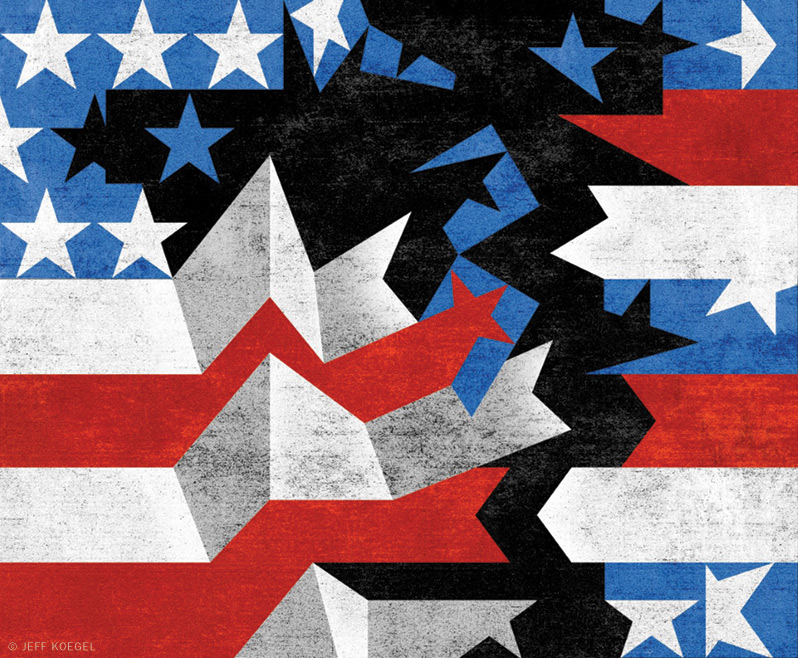
A new book from the Annenberg Public Policy Center details how the 2020 election continues to shape US politics.
Whether or not the 2024 presidential election turns out to be a rematch between Joe Biden Hon’13 and Donald Trump W’68, the issues Democrats and Republicans will be fighting over are likely to sound familiar. Arguments central to the 2020 election concerning the economy, pandemic response, race and social justice, and the legitimacy of the US electoral system played prominent roles in the 2022 midterms and are still very much with us.
At the same time, 2020 reflected an extraordinarily turbulent election season: “One has to go back to 1918 or even 1864 to find years in which the United States faced as many crises as it did between January 20, 2020, and January 20, 2021, the final year of Donald J. Trump’s presidency.” That’s according to a new book, Democracy Amid Crises: Polarization, Pandemic, Protests, & Persuasion, by the Annenberg IOD Collaborative, a group of 10 scholars from Penn; Temple; the universities of Michigan, Arizona, and Buffalo; Georgia State; and University College, London.
The four crises they identify are the COVID-19 pandemic; the resulting economic hardship and uneven recovery; protests, in some cases violent, calling for racial justice that followed the murder of George Floyd; and finally, Trump’s baseless claims of election fraud after losing to Biden, leading to the attack on the US Capitol on January 6, 2021.
Billed as “a resource for political scientists and communication scholars,” and thick with charts and diagrams, the book draws on survey data collected from more than 9,000 people in Florida, Michigan, Pennsylvania, and Wisconsin, who were asked more than 1,000 questions over 14 waves of studies about the election and its aftermath.
“Given the strength of our dataset, with surveys in the field through the inauguration, readers can follow the changing attitudes of our very large panels,” Annenberg Public Policy Center (APPC) director Kathleen Hall Jamieson said in a statement. “This story doesn’t end with Election Day. The book also shows how subsets of voters came to think the election was stolen, and violence may be necessary to defend the American way of life.”
On the key question of how Biden won, the answer seems to be that he succeeded in convincing voters in battleground states that his view of the task facing the next president—that addressing the pandemic superseded other issues—was the correct one, allowing him to achieve the rare feat of displacing the economy as voters’ main concern. “While Trump said he did a good job with the economy pre-COVID, Biden said you can’t fix the economy until you’ve handled COVID,” said lead author Matthew Levendusky, a Penn professor of political science. “And even Trump’s strongest supporters didn’t think he did a good job managing the pandemic.”
Teasing out which of the four crises mattered most is “a fool’s errand,” the authors write, but they point to several lessons that may bear on US politics going forward.
First is the “normalization of violence.” The belief that “recourse to force is justified when other means of securing redress of grievances have been exhausted” goes back to America’s origins, they note. “Some of the January 6 rioters did indeed identify their actions with those of the American colonists who rebelled against British rule,” even though their actions in storming the Capitol were antithetical to “the founding of a nation committed to due process and the rule of law.”
Long before the Capitol attack, however, the “tensions of 2020 … had spawned violence.” While Biden framed the summer’s protests as “part of the nation’s long struggle for racial justice,” Trump “argued they were exemplars of chaos abetted by antifa,” leading to “clashes between MAGA-flag-carrying counterprotesters and those carrying signs reading ‘Black Lives Matter,’ as well as the beatings of police officers in the riot at the Capitol.” The plot to “kidnap, try, and possibly execute” Michigan Governor Gretchen Whitmer in October 2020 “foreshadowed” the noose brought by insurrectionists who called for the hanging of Vice President Mike Pence. “It is not simply that violence is legitimized; it is also that violence, not politics, is seen by some as the only way to resolve our conflicts.”
Even earlier, Trump’s sanction of “the threat of violence” goes back to the start of his presidential campaign and threads throughout his presidency, from his sympathetic reactions to the white supremacist rioters in Charlottesville, Virginia, in 2017, to the rioters in the January 6 attack.
This attitude has also “infiltrated the language” of other Republicans, like US Representatives Marjorie Taylor Greene and Paul Gosar. Perhaps most dangerously, they write, many others in the party have remained silent rather than speaking out against violence. “The whole point of politics is that it is the nonviolent resolution of conflicts. Losing sight of this sends the nation down a dark path.”
The “polarization of public health” is another crisis the book explores. Their surveys confirmed how differently Democrats and Republicans regarded the seriousness of the threat of COVID-19—but they also found that views toward public health officials and agencies grew much further apart as their surveys went on. “Across time, modest differences became gulfs. Effectively apolitical scientific institutions became just another set of partisan objects.”
And these behaviors may extend to other prevention efforts. One example: They cite 2021 data showing a 25-point gap between Democrats and Republicans in receiving the flu vaccine, whereas historically both groups got their shots at similar rates.
Finally, they point to the lasting impact of “electoral delegitimization.” Despite overwhelming evidence to the contrary, Trump and his base continue to advance claims of election theft. And while many Republican leaders “accept Biden’s legitimacy,” others “have embraced [Trump’s] rhetoric about voter fraud.” This issue “will hover like a shadow over future elections,” the authors predict. “While there are always partisan gaps in perception of the fairness of the outcome of elections, a worrisome proportion of the citizenry may now be disposed to accept an election result as legitimate only when their side wins.”
A few “citadels” did hold fast in 2020. The US military leadership successfully maintained its traditional distance from politics. The courts, including a number of Trump-appointed judges, dismissed voter fraud claims and sometimes rebuked the Trump lawyers advancing them. And local election officials defended their work and the integrity of elections.
But while “the guardrails survived a crash test” in 2020, the Annenberg IOD Collaborative concludes, “that is not a reason to assume that they will hold in 2024 and beyond.” —JP





I can only wonder about the political affiliations of the “10 Scholars” that were part of the Annenberg IOD Collaborative and their choice of the four crises that affected the 2020 election. But I am used to these kinds of distortions from academia.
One of the dirtiest Presidential election tricks ever, was the coordinated suppression of the validity of the Hunter Biden laptop by the FBI, CIA, our current Sec. of State, Twitter and, 51 stooges from the intelligence community. Regardless of Hunter Biden’s personal proclivities, the laptop offers copious evidence detailing H.B.’s work coordinating the meetings of private interests with his father, for significant compensation. If the media had fairly and diligently reported the details of the Biden influence peddling business, would 20,000 ~ 100,000 voters in eight key states have voted differently?
For you all to report on what affected the 2020 election and ignore the media’s coordinated dismissal of the contents of the laptop, is troubling indeed.
Btw, I voted for neither Donald Trump nor Joe Biden.